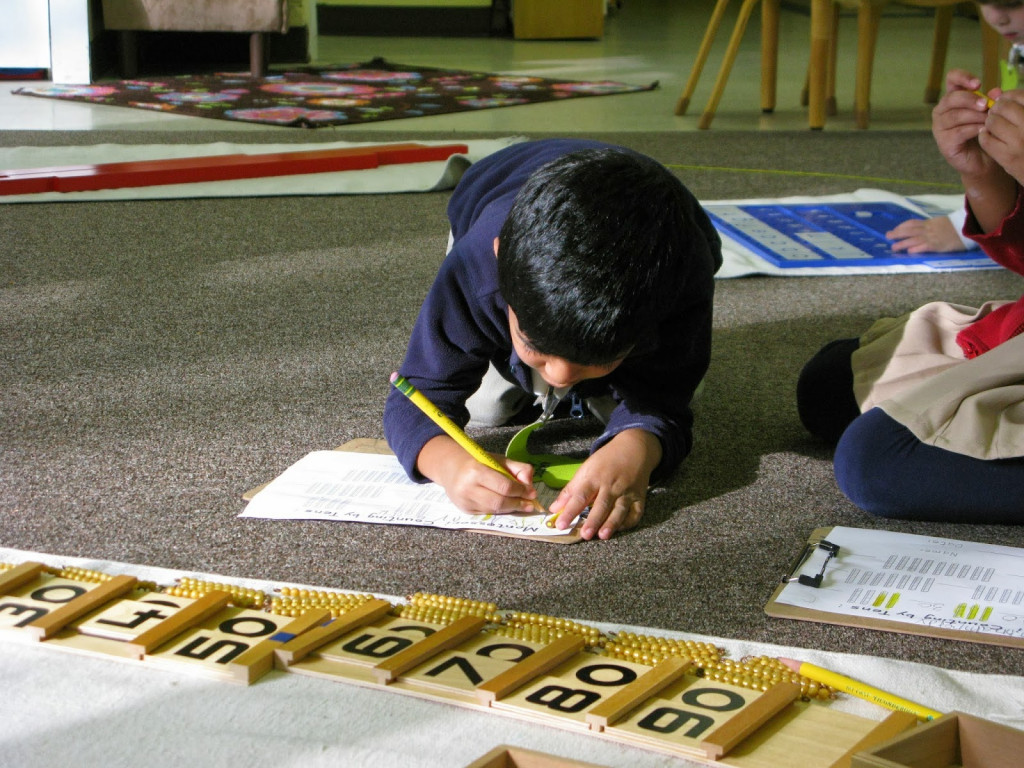A child can learn basic concepts of mathematics in either of two ways. He can learn by using concrete materials during the years when he enjoys manipulating equipment; or he can learn by abstract methods when he is in the elementary grades. Dr. Montessori demonstrated that if a child has access to mathematical equipment in his early years, he can easily and joyfully assimilate may facts and skills of arithmetic. On the other hand, these same facts and skills may require long hours of drudgery and drill if they are introduced to him later in abstract form.
After she observed that the child who becomes interested in counting likes to touch or move the items as he enumerates them, Dr. Montessori designed concrete materials to represent all types of quantities. In a Montessori environment, a child not only sees the symbol for 1, 100, or 1/2, he can also hold each of the corresponding quantities in his hand.
Later, by combining this equipment, separating it, sharing it, counting it, and comparing it, he can demonstrate to himself the basic operations of arithmetic. The activity gives him the satisfaction of learning by discovery rather than by being told. Eventually he develops an early enthusiasm for the world of numbers.
The Red and Blue Rods:
In the Montessori Classroom the child’s first introduction to the numbers is made with a set of red and blue rods representing the quantities one through ten. The teacher helps the child to count the alternating red and blue sections of each rod as he arranges them in stair-like formation.
The Spindle Boxes:
The Spindle Boxes represent a parallel exercise in associating the numerals with the proper quantities.
The Numerals and Counters:
In this exercise both the symbols and the quantities are loose and both numerals in ascending order. When placing the appropriate number of red discs under each figure, the child puts the discs in rows of two. Each odd number has only one disc in the bottom row. This arrangement automatically illustrates the odd and even numbers.
The Sequin Boards:
To learn the “teen” numbers, the child uses equipment known as Sequin Boards. The boards have the numeral 10 printed nine times in a row. The child forms the number eleven by sliding the figure 1 over the zero of the first 10. This shows her concretely that the number eleven is made up of 10 plus 1. Another set of Sequin Boards is available for learning the numerals 21 through 99.
The Golden Beads and Fraction Materials:
The famous Golden Bead Material designed by Dr. Montessori to illustrate the decimal system. There are bars to represent a Unit, a Ten, a Hundred and a Thousand. The children already know the terms “square” and “cube” from their work with the geometric material.
The children are introduced to the decimal system with 3 basic experiences. First they build quantities with the bead material. The teacher starts with simple numbers. She say, for e.g., “Bring me 5 Tens and 7 Units.” Eventually the children enjoy accumulating large quantities on a tray, such as 8 Thousands, 4 Hundreds, 3 Tens and 7 Units.
In the second exercise, the children find cards to represent the numbers the teacher gives them orally, such as 8 Tens and 3 Units. Finally, the learn to combine the numerals on the cards with the corresponding quantity of the bead materials. The children learn to translate the numbers, such as 7 Tens and 1 Unit into 71.


